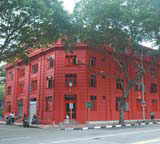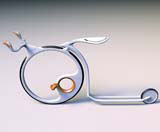Red dot alert

With designers increasingly looking East for new business and ideas, Max Fraser visits Red Dot’s new design museum, which opened in Singapore last month with the intention of stimulating local talent.
There are only a handful of design award schemes that really have global reach, such as the German Red Dot awards. Indeed, a Red Dot award has come to represent an industry seal of approval, and, since its rebranding in 2000, it has become a truly international competition, attracting thousands of entries across three major design categories – communication, product and concept.
Red Dot has a home in the form of the Design Zentrum Nordrhein Westfalen near Essen in Germany – a museum housing over 1000 Red Dot-winning products, from jewellery, mobile phones, watches and televisions, to food processors, computers, chairs and cars. This non-profit centre was founded in 1954 by the Confederation of German Industry to create a permanent exhibition of exemplary industrial products. The global nature of its content and ever-increasing numbers of international competition entries prompted the institution to launch its first overseas museum last month in Singapore, under the direction of accountant-turned-design entrepreneur Ken Koo. To coincide with the opening, the inaugural Red Dot: Design Concept award was held, which ‘aims to encourage and promote the creative energies of young talent, whose visions and ideas may well give us a glimpse of the world in the future’, according to Professor Dr Peter Zec, president of Red Dot worldwide.
Ken Koo has previously worked as a link between designers and industry, presenting Singapore designs at trade fairs in New York, Paris and Frankfurt. His desire to bring young talent to the fore was the motivation for this new Red Dot award, which attracted over 630 entries from 32 countries. Out of these entries, 59 winners survived the judging process, distinguishing themselves with innovative design concepts. Of those 59 winners, ten were awarded the Red Dot: Best of the Best award. And, as if that wasn’t recognition enough, three of those winners – all of them from Asian countries, indicative of a growing sophistication in design innovation there – were presented with the Red Dot: Luminary award, worth $5000 (£2900). The three Luminary award-winning projects are the Freewill lightweight bicycle by Ahn Sang-Gyeun of Korea, Yoga and Connection Touch by a team of designers at Lenovo Beijing, and another two-wheeler, the Skid Scooter, designed by local student Yong Jie Yu. The opening of the museum was aptly timed to coincide with the first Singapore Design Festival – another sign that nations are recognising the importance of design innovation for the progression of cultural exchange and economic growth. The growing onus placed on the import and export of talent and skills seems to have governments jostling for the top spot in the international reputation stakes.
Any foreigner visiting the museum might question why Singapore was chosen as the home for such an institution. ‘Geographically, Singapore is at the heart of Asia and boasts a solid infrastructure as a metropolitan, developed city,’ suggests Koo. ‘Politically, it is a country without any historical baggage – our neutrality has earned us good international standing. There is also a large base of multinationals here that are leaders in the field of design, and our government is increasingly supporting pro-design policies.’
Historically, this small island has acted as the trading crossroads of Asia and, since independence from British colonial rule, the country has been grappling to invent an identity of its own. You might expect the Singapore Design Festival (run by the Ministry of Information, Communications and the Arts, and recently formed by Design Singapore Council) to unveil to the world the fruits of the country’s home-grown talent, but much of it, this year, comprised presentations by foreign outfits.

Is there much of a domestic design scene? ‘Over the past two years, even discounting the government’s efforts, the increase in design-related activities at the grassroots level is apparent and encouraging,’ says Koo. ‘There is an active group of design and creative entrepreneurs producing very interesting work. They are often driven by their passion for design, but are mindful that their work needs to find a commercial niche. I think this is a great success formula for our design industry. The momentum is gathering and the vibe is upbeat. If you visit Singapore in two years’ time at the next design festival, you will see a strong presence from our local design talent.’
The hard-to-miss 1920s red building in Singapore’s business district – home to, not only the Red Dot museum, but also designers’ studios and stores – promises to act as one of the creative hubs for such talents.
-
Post a comment



